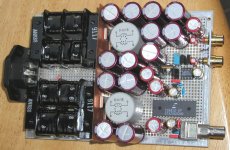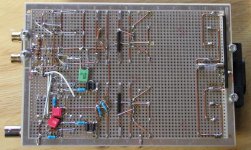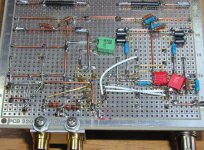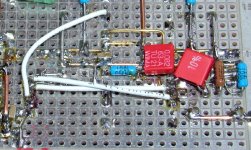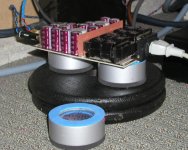I didn't try any of them yet. I'm only going by Elso suggestions, but his taste is changing so often.
First I'll try TDA1541 I have in my Marantz CD94. I will do non-oversampling mod. I just built gain clone last week and I'm really surprised by the sound of it. Makes me think if building all those class A amps is worthwile inokio:.
inokio:.
What strikes me is the liveness and very realistic presentation which is quite opposite to the polite and proper (smother) sound of the high-end superamps. Music seems to be music without second thoughts about quality and you simply have to enjoy it.
First I'll try TDA1541 I have in my Marantz CD94. I will do non-oversampling mod. I just built gain clone last week and I'm really surprised by the sound of it. Makes me think if building all those class A amps is worthwile
What strikes me is the liveness and very realistic presentation which is quite opposite to the polite and proper (smother) sound of the high-end superamps. Music seems to be music without second thoughts about quality and you simply have to enjoy it.
"Listening Styles"
Hi till ,
I will do my best to explain it in my best English,
When I worked as a salesman in a HiFishop a lot of people came in to listen to and choose a loudspeaker. As a salesman I was eager to discover the taste of the customer i.e. "English" style or "German" style.
The English were KEF and B&W speakers, the German Magnat f.a.
The English were subdued and NEVER harsh but had not a very open soundfield. The German had plenty of highs and open soundfield but are also causing listening fatigue.
Also of merit is the following story when I was working at the repair/service department: [You pay attention Bernard/Dice 45?, this is about my bio]
I customer brought in two small English loudspeakerboxes with the complaint no highs. We always immediately asked: "You did have a nice party?" And the amazed customer: "How do you know that?"
In this case the tweeters were fired and also the series cap in the crossover. In those days all English manufacturers used bipolar electrolytics. These were for 80% responsible for the "English" sound. I decided to do a good job and replaced the electrolytics by polypropylene filmcaps. Two days after completing the repair the custumer was back complaining that I had murdered the <B>Fine English Sound</B> of his loudspeakers! Oh boy what did I do. I soldered resistors in series with the tweeters but it got never OK.
A polite sounding DAC is excellent for chamber music like Bach Trio Sonata No.5 in C major, BWV 529 but will totally fail on the explosive violence of the opening thunderstorm and following basbeat and percussion instruments of OSIBISA in Woyaya. The song is called Beautiful Seven
Did I make myself clear???
Hi till ,
I will do my best to explain it in my best English,
When I worked as a salesman in a HiFishop a lot of people came in to listen to and choose a loudspeaker. As a salesman I was eager to discover the taste of the customer i.e. "English" style or "German" style.
The English were KEF and B&W speakers, the German Magnat f.a.
The English were subdued and NEVER harsh but had not a very open soundfield. The German had plenty of highs and open soundfield but are also causing listening fatigue.
Also of merit is the following story when I was working at the repair/service department: [You pay attention Bernard/Dice 45?, this is about my bio]
I customer brought in two small English loudspeakerboxes with the complaint no highs. We always immediately asked: "You did have a nice party?" And the amazed customer: "How do you know that?"
In this case the tweeters were fired and also the series cap in the crossover. In those days all English manufacturers used bipolar electrolytics. These were for 80% responsible for the "English" sound. I decided to do a good job and replaced the electrolytics by polypropylene filmcaps. Two days after completing the repair the custumer was back complaining that I had murdered the <B>Fine English Sound</B> of his loudspeakers! Oh boy what did I do. I soldered resistors in series with the tweeters but it got never OK.
A polite sounding DAC is excellent for chamber music like Bach Trio Sonata No.5 in C major, BWV 529 but will totally fail on the explosive violence of the opening thunderstorm and following basbeat and percussion instruments of OSIBISA in Woyaya. The song is called Beautiful Seven
Did I make myself clear???
Taste
I feel a bit honoured that you are following my suggestions. I did not change my taste and if Tone had not sent me some TDA1543 I had never tried these and sticked to the AD1865N-K.
Before the AD1865N-K I had ordered two TDA1543 but got two TDA1543<B>A</B> and these are useless on the CS8412.
I listened quite a while to the AD1865 and it was me who pointed all to the AD1865N-K (highest selection grade).
I believe it is best to try the TDA1543 as it costs almost nothing and see if you like it.
Hi Peter,Peter Daniel said:I didn't try any of them yet. I'm only going by Elso suggestions, but his taste is changing so often.

I feel a bit honoured that you are following my suggestions. I did not change my taste and if Tone had not sent me some TDA1543 I had never tried these and sticked to the AD1865N-K.
Before the AD1865N-K I had ordered two TDA1543 but got two TDA1543<B>A</B> and these are useless on the CS8412.
I listened quite a while to the AD1865 and it was me who pointed all to the AD1865N-K (highest selection grade).
I believe it is best to try the TDA1543 as it costs almost nothing and see if you like it.
Much Obliged
I am much obliged for sending all these AD1865N-K Troels.!
I ordered two samples from AD in December 2001, but did not receive these. I don't remember where I got the idea from. You helped me out in March 2002.
Thanks very much again!


Hi Troels,tbla said:I listened quite a while to the AD1865 and it was me who pointed all to the AD1865N-K (highest selection grade).
yes....but who pointed it to you?????? bobbob


I am much obliged for sending all these AD1865N-K Troels.!
I ordered two samples from AD in December 2001, but did not receive these. I don't remember where I got the idea from. You helped me out in March 2002.
Thanks very much again!
Wombat said:
I don´t know the 1702, but the PCM 63 is a waste of time today i believe.
Wombat
1702 and 63 are VERY similar, just look at both datasheets (BB might have even copied the measured data of 63 into 1702 spec)
I am still happy with 63-K, it needs lot of attention in the application though:
http://members.chello.nl/~m.heijligers/DAChtml/dactop.htm
best regards
-
Re: I that what you are talking about?
Hi
Why I appreciate releasing ready to use schematics, I have one remark:
Why the high (10k) series resistance in the clock buffer line ?
Inducing noise THERE is fatal !
all the best
Peter Daniel said:That schematic was posted before by Ergo.
Hi
Why I appreciate releasing ready to use schematics, I have one remark:
Why the high (10k) series resistance in the clock buffer line ?
Inducing noise THERE is fatal !
all the best
Re: Re: I that what you are talking about?
Hi Guido,
No 10k in my scheme!
Guido Tent said:
Hi
Why I appreciate releasing ready to use schematics, I have one remark:
Why the high (10k) series resistance in the clock buffer line ?
Inducing noise THERE is fatal !
all the best
Hi Guido,
No 10k in my scheme!
Re: nos dac
It is one of the tricks. I will not disclose all....
Hi Troels,tbla said:i'm pretty shure that the hole trick is in the analog filtering....
troels
It is one of the tricks. I will not disclose all....

Re: Re: Re: I that what you are talking about?
Hi Elso
I refer to
http://www.diyaudio.com/forums/showthread.php?s=&threadid=5798&perpage=15&pagenumber=1
about half way the page
it says 10k, no ?
Elso Kwak said:
Hi Guido,
No 10k in my scheme!
Hi Elso
I refer to
http://www.diyaudio.com/forums/showthread.php?s=&threadid=5798&perpage=15&pagenumber=1
about half way the page
it says 10k, no ?
Re: Re: Re: Re: I that what you are talking about?
Yes I know, I was just pointing to my scheme which is much more simple, only two components, and has no 10k.
That's all .
Hi Guido,Guido Tent said:
Hi Elso
I refer to
http://www.diyaudio.com/forums/showthread.php?s=&threadid=5798&perpage=15&pagenumber=1
about half way the page
it says 10k, no ?
Yes I know, I was just pointing to my scheme which is much more simple, only two components, and has no 10k.

That's all .
So here we go, finally my first non-oversampling DAC. This one is a compact version, so everything is on one board, including 2 transformers. I used one for receiver chip, the other for a single TDA1543.
I based my circuit mostly on a first Kusunoki DAC, I still like the beauty of passive filtering and simplicity. I used those 2.4mH common mode chokes, by ROE, I bought years ago and mosly Elna caps, with few Cerafines.
Regulation for CS8412 is done by two TL431 diodes, one for digital section, one for analog section. Regulation for DAC is done by a single Mosfet, with a trimpot for votage adjustment and 4,700 at the gate. Overall I think I used about 30,000u at the DAC PS. I also used SMD caps for bypassing directly at the IC pins (famous triplets).
I based my circuit mostly on a first Kusunoki DAC, I still like the beauty of passive filtering and simplicity. I used those 2.4mH common mode chokes, by ROE, I bought years ago and mosly Elna caps, with few Cerafines.
Regulation for CS8412 is done by two TL431 diodes, one for digital section, one for analog section. Regulation for DAC is done by a single Mosfet, with a trimpot for votage adjustment and 4,700 at the gate. Overall I think I used about 30,000u at the DAC PS. I also used SMD caps for bypassing directly at the IC pins (famous triplets).
Attachments
Everything is done p2p and it took me one day to figure the layout and do connections. I placed DAC in a socket, so I can experiment with paralleling. Currently supply is 5V. I like working with p2p, because it provides more flexibility when working with limited space.
Attachments
As to the sound, it is pretty good. My first impression is that I can't really find nothing wrong, the bass is more detailed and probably more punchy than SF Transdac. One word that describes the sound best is probably "seductive". I didn't use any filtering in a DAC, but I didn't observe any ringing, harshness or whatever. Maybe because I used Vishays S102 as 1K conversion resistors. From my experience, Vishays sound very mellow.
Attachments
I did some more experimenting; replaced single DAC chip with two in parallel and indeed it seems like single chip sounds better. Two in parallel give more authority, but at the cost of ambience and low level detail. Also it seems like 5V supply is also a good choice. With higher voltage (I could only go as high as 7V) it seems like sound is messed up.
So far your recommendations are in line with my findings. I have slightly not enough gain in my setup. The resistors are 1k, what about using higher values to increase gain?
Overall sound is indeed something special. In some way it's different from what I'm used in digital (but mostly with one chip and 5V supply). It seems to be very delicate and previously irritating recordings are now very listenable. it also seems like the very fine detail (in trebles) is somewhat not present, but I also find that the bass notes are better defined and more substantial. Midrange is very natuaral as well.
I can honestly say that this approach to digital definitely has sense and is worth further pursuing.
So far your recommendations are in line with my findings. I have slightly not enough gain in my setup. The resistors are 1k, what about using higher values to increase gain?
Overall sound is indeed something special. In some way it's different from what I'm used in digital (but mostly with one chip and 5V supply). It seems to be very delicate and previously irritating recordings are now very listenable. it also seems like the very fine detail (in trebles) is somewhat not present, but I also find that the bass notes are better defined and more substantial. Midrange is very natuaral as well.
I can honestly say that this approach to digital definitely has sense and is worth further pursuing.
It's 18 ga. bare copper wire. I bought a roll of PVC insulated wire and as use it, I remove insulation. It doesn't oxidize that way 
I'm also getting more skilled at p2p as I practice, and while before I would disregard that sort of technique, now I approach it as a form of an art
Here's a nice detail, notice stacked SM caps between power pins and ground, underneath receiver chip. The golden wires are cut offs from Rikens.
I'm also getting more skilled at p2p as I practice, and while before I would disregard that sort of technique, now I approach it as a form of an art
Here's a nice detail, notice stacked SM caps between power pins and ground, underneath receiver chip. The golden wires are cut offs from Rikens.
Attachments
I tried yesterday with mounting that board on a sort of platform, but found out that it sounds the best when not mounted to anything, just two big feet. Which confirm my previous findings about importance of vibrations control.
Kusunoki also mentions importance of mechanical construction in his interview with TNT Audio:
>>TNT-AUDIO >
There are also at least a few design (some industrial, some DIY) filters that in some way introduce a drop in high frequencies minimizing phase rotation. Do you consider this a reasonable way to eliminate digital sources edginess?
KUSUNOKI SAN >
With my experience in building DACs, there are no direct relationship among the edgy, harsh sound of the digital source and its frequency response and phase characteristics. The edginess of sound is generated at different places - the DAC's mechanical construction is particularly important.
<<
Kusunoki also mentions importance of mechanical construction in his interview with TNT Audio:
>>TNT-AUDIO >
There are also at least a few design (some industrial, some DIY) filters that in some way introduce a drop in high frequencies minimizing phase rotation. Do you consider this a reasonable way to eliminate digital sources edginess?
KUSUNOKI SAN >
With my experience in building DACs, there are no direct relationship among the edgy, harsh sound of the digital source and its frequency response and phase characteristics. The edginess of sound is generated at different places - the DAC's mechanical construction is particularly important.
<<
Attachments
- Status
- This old topic is closed. If you want to reopen this topic, contact a moderator using the "Report Post" button.
- Home
- Source & Line
- Digital Source
- Non Oversampling DAC-complementing CD-PRO
